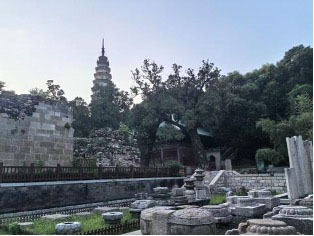Many people visit real landmarks featured in Black Myth: Wukong.
By Zora Yan
Fascinated by the astonishing temples and mesmerizing landscapes in Black Myth: Wukong, many enthusiastic gamers make a beeline for the real-life locations featured in the blockbuster video game.
Released on August 20, 2024, Black Myth: Wukong, China’s first AAA video game – an unofficial designation for premium games with large budgets and long development times, amassed a sale of 8.4 million copies in just three days.
Inspired by the classical novel Journey to the West, the action role-play game also topped the Most Played Games list on Steam, one of the largest digital distribution platforms for video games, with more than 2.2 million concurrent players, not only in China but worldwide.
“I can’t imagine that the game scenes are really so realistic that they look so close to those in the real world and I have an opportunity to visit there for free!” says Wang Changchun, a Black Myth: Wukong player.
Ten days after the game’s release, Wang took a four-hour high-speed train ride from Wuhan to visit the scenic Zhangjiajie National Forest Park. Known for its towering quartzite sandstone pillars, these majestic pillars served as inspiration for the floating mountains seen in both the game and the movie Avatar.

Through meticulous research across many provinces and cities in China, the game’s scenes extensively replicate ancient Chinese architecture, and relics not only captivate gamers but also breathe new life into China’s tourism.
Some of the landmarks featured in the game offer free entry to players who have completed specific game levels.
Wang got free tickets to the Zhangjiajie National Forest Park and can save RMB ¥227 (US $31.88) after showing staff at the tourist ticket office his purchase records and completion records of Black Myth: Wukong.
“While exploring Zhangjiajie, I was fortunate to have the company of wild monkeys. It felt like I had transformed into Wukong, the Monkey King, leading a loyal group of followers on my challenging journey,” he says.
After the visit, Wang posted a travel guide on Xiaohongshu (a Chinese social media platform) to help more players to know the landscape depicted in the game and how to obtain free tickets.
Within a week, his post got 50,000 views and he has received many private messages and comments from other gamers telling him they also want to go.
Another game player Wang Xiaopeng earns a lifetime free visit to Lingyan Temple in Shandong, another ancient temple site that is featured in the online game after completing all the challenges in the first three parts of this game.
“When I saw on social media that the temple offers free lifetime admission tickets, I quickly finished these chapters within a week,” Wang says.
“The game is extremely difficult, and I have to spend six hours on it every day because there are so many monsters that need to be defeated,” he adds.
The breathtaking real-life scenery in Lingyan Temple surpassed his expectations and sparked his curiosity to explore other tourist destinations featured in the game.

Within a month, Wang visited nine historical locations in the game in Shanxi-Qianfo Temple, Foguang Temple, Yungang Grottoes, Xuankong Temple, Huayan Temple, Shanhua Temple, Chongfu Temple, Nine Dragon Wall and Hengshan Mountain.
“I feel like visiting the scenic spots one by one in the game is just like going on a journey with the game protagonist, Monkey King,” he adds.
What impressed Wang the most was Qianfo Temple where Wukong battles the final boss in the third chapter of the game. While playing, he was amazed by the colour design and intricate character carvings of the temple in the game.
“When I arrived at the actual site, I discovered that it is far more exquisite than what is shown in the game. I greatly admire how ancient people were able to carve such delicate patterns under harsh conditions!” the player says.
Wang believes that the collaboration between scenic spots and games in the tourism industry provides an excellent opportunity for more people to visit famous historical sites and personally experience the excitement beyond what games can offer.
“Following the release of Black Myth: Wukong, visitor numbers to Shandong Lingyan Temple surged by 128 percent compared to the previous year,” says Cha Tianqi, the strategy manager of Shandong Lingyan Temple Tourism Corporation.
Shandong Lingyan Temple also offers a lot of derivative products to visitors, such as gourd-shaped dolls that appear in the game, ceramic toys, and fridge magnets featuring the image of Wukong.
”We are surprised that gourd-shaped dolls were sold out within two days after going online,” Cha says.
Wei Changren, founder of btiii.com, a tourism-related financial news portal, points out the game has boosted tourism across China.
“People’s passion for the video game, and the ‘set-jetting’ tourism that the game has brought about, show people’s growing confidence in Chinese culture,” Wei says.
Edited by Molisa Meng
Sub-edited by Cynthia Chan







































